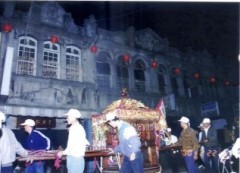The Adventure of Little Crickets
The Beauty of Sinhua country.
|
||||
Legend of the Eight-trigram Spider Cave |
||||
In the past, Tavokan was said by Feng-shui professionals to be the Eight-trigram Spider Cave. The center of the cave was in the old San Jao Yong Tsai, also the crossroad in front of the Farmer's Association. Here, eight routes radiate in eight directions. The four main lines approach Tainan, Kwan-miao, Yu-ching, and Sin-shih. The four secondary lines approach Da-wan, Feng-ko, Hu Tou Pi, and Chao-keng. |
||||
Legend has it that the spider spirits in the Eight-trigram cave make webs and dirty air, causing unrest in the region. We heard that every year after Chinese New Year, because of the foul play of spider spirits, Tavokan women seem like they are possessed; they do not do housework and act out of control, so people had to get help from the gods. After the goddess Mazu appeared and instructed the residents, they called on the Sever Star Gods to help. The Seven Stars mean the seven temples in the village: Wu-an Temple, Bei-ji Temple, Hu-an Temple, Tai-zi Temple, Guan-yin Temple, Chin-shui Temple, and Chao-tien Temple. So, starting with Lantern Festival, everyone would hold torches, invite the gods, bang drums, parade all over the streets, and work together to clear away the spider webs and the annoying spider spirits. |
 |
|||
Activity Features |
||||
The Eighteen Jao tradition in Sin-hua is different from that in other areas; most other places have the Ya Mazu activity. Because Sin-hua has the aforementioned activity, it is unique. On January 18 of the lunar calendar, Sin-hua has the Eighteen Jao activity at night. Everyone gathers in front of the Mazu Temple, draw lots to decide on the route they will take the eliminate spider spirits. Like other temple activities, each temple would send out their team; this is an important event that occurs in the leisure time away from farm work. Sadly, as a result of Kominka under Japanese rule, this important temple activity was prohibited, and did not recommence until 1995, after that, it was held again in 2000. The whole event lasts three to four days, and includes food donations, chanting by experienced monks, performance of art groups, parade by gods, parades by flower cars. The most recent occurrence of this tradition was even combined with local industry and culture; a point of balance was found between tradition and modernity. |

The teams of temple of Eighteen Rao activities |
|||
Editor: Ming Hsun |
||||
 Eighteen Jao
Eighteen Jao